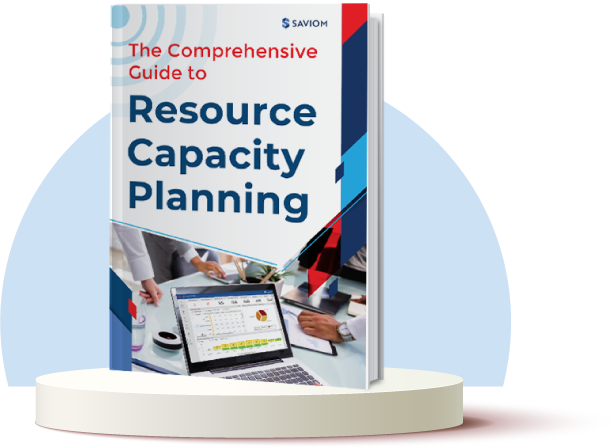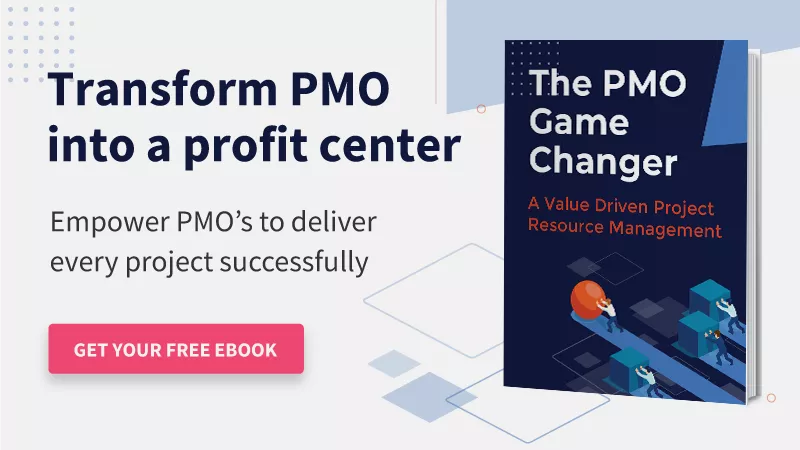Imagine you are running a large multinational company with multiple portfolios. Suddenly you start facing resource-centric challenges such as skill shortages, lowered productivity, etc., all of which have a detrimental effect on project delivery. How do you forecast these resource risks and find a way to mitigate them?
Well, resource management plays a crucial role here. It provides enterprise-wide visibility that facilitates managers to foresee the resource demand and risks within projects. It also helps in future-proofing the workforce by providing data-driven insights for timely decision-making.
In addition, implementing resource management techniques into PPM help organizations use resources more effectively and improve the health of the overall project portfolio.
This article will explain how resource management can help in defining the future of PPM in detail.
Let’s begin by briefly understanding the objective of project portfolio management.
What is the purpose of project portfolio management?
The ultimate objective of PPM is to forecast future opportunities, evaluate the potential of every portfolio & project and formulate a plan to manage them efficiently. That way, the organization becomes nimbler and more responsive to the constantly changing demands.
According to PMI, “Portfolio framework is designed to manage multiple portfolios across the enterprise and meet long-term objectives through efficient decision-making on portfolios, programs, projects, and operations.”
The main emphasis of PPM is to ensure that the portfolio’s outcomes support the organization’s long-term goals. It sets out a methodology to predict potential problems, review progress toward strategic goals, and make the most efficient use of resources. It also helps project managers to control the budget, address stakeholder issues, etc.
Given the objective of the PPM strategy, let’s now understand what the future landscape of PPM will look like.
Read More: Understand 10 Benefits of an Effective Project Portfolio Management Strategy
What will be the future landscape of PPM?
The influence of the digital revolution on every aspect of Project Portfolio Management (PPM) has been substantial.
According to research and markets, the global demand for PPM is anticipated to increase by USD 1.6 billion by 2024.
Digital disruption is transforming the PPM landscape from analog information, annual planning, manual processes, and traditional delivery methods to agile, data-driven business processes for efficiency and innovation. In simple words, traditional PPM methods come with siloed data and disparities in resource productivity, visibility, and collaboration. At the same time, modern PPM fosters efficient management of projects and resources. It also enhances work automation and collaboration that empowers resources to do the right work profoundly.
Today, managing enterprise resources has become a fundamental skill in PPM. Project managers need to evaluate resource needs across multiple projects in advance. They must use allocated resources productively while ensuring resources are neither over- nor under-allocated. For this reason, resource management becomes a key factor in PPM.
That being said, PPM is the foundation of the project management ecosystem. Therefore, project managers must repeatedly touch base with existing strategies and evolve exponentially. If not, they are likely to face challenges. Let’s look into the details here.
Some resource management challenges faced in PPM
Today businesses are expanding their geographical boundaries, and hence resources from different locations are working cohesively. Therefore, it is not feasible for managers to manually keep a tab on every project team and their productivity. The majority of resourcing constraints arise when organizations do not have a dedicated tool or sometimes when they don’t use it the right way.
Some of the most common challenges of resource management in project management:
Lack of visibility against evolving demands
Many organizations often lack clarity into the future resource capacity and demand as well as other metrics like resource availability and utilization. This poor visibility restricts resource managers from procuring the right resources at the right time and hence resort to unplanned hiring activities. It leads to eleventh-hour hurdles and causes budget and schedule overruns.
Project failure due to improper resource allocation
During scheduling resources, managers must ascertain that the resources are assigned to tasks as per their skills and competency. If not, it will have an adverse effect on the project delivery. It will lead to resource wastage and ultimately derails projects off their track.
Inappropriate resource requisition workflow
In many organizations, new projects with resource demand emerge every now and then. So, the absence of automated resource requisition workflow could lead to conflicts among managers for the same resource. For example, project managers resort to endless trails of emails in the absence of legitimate software. As a result, critical projects get delayed and decline in profitability.
Read More: PMO resource management challenges: What you need to know
Lowered employee productivity due to overutilization
Allocating resources on a whim without analyzing their existing bookings and priorities can be troublesome. Managers might end up double-booking the resources for multiple projects or activities. It will lead to the overallocation of resources, resulting in lowered employee productivity and project quality.
Decrease in profitability due to budget overruns
Inaccurate project estimates, poor capital management, and hiring high-cost resources can all lead to budget overruns in a project. It not only causes financial loss for an organization but also affects a firm’s profitability severely.
Inappropriate risk management framework
In relation to resource risk assessment, many organizations have an inaccurate risk management framework. Therefore, managers find it challenging to mitigate risks efficiently. This negatively affects the overall health of projects and eventually leads to business failure.
Keeping these challenges in mind, let’s see what role modern resource management plays in mitigating these resource-centric challenges well in advance.
Read More: How to Mitigate Resource Risk in Project Management?
Role of futuristic resource management software to support PPM
Resources are the greatest asset of an organization that drives the projects to success. Therefore, it is vital for project governance teams to keep their efficiency and performance at their best. However, how can they manage resources dispersed across departmental and geographical boundaries?
This is where a project resource management solution supports PPM. Here’s the list:
Efficient resource planning with what-if analysis
Modeling and simulation techniques enable managers to build scenarios and derive the best possible outcome. One can compare the changes made in each scenario on various project finances such as budget, revenue, and ROI before applying the viable option to the actual resource plan.
Replace silos of spreadsheets with real-time scheduling systems
With robust resource management tools, managers can replace silos of spreadsheets and get unmatched visibility of resource capacity and their skill set. Based on this information, managers can then schedule resources for the right job at the right time.
Introducing a well-defined resource requisition workflow
An automated resource requisition and workflow help project managers raise a request in a timely and systematic manner. Depending on that, resource managers can fill the open positions based on project priority. Moreover, the tool minimizes internal conflicts for critical resources and helps to foster a shared service model effectively.
Read More: Project Portfolio Management- How Resource Capacity Planning can be a Game-Changer
Reduce disparity in data with embedded business intelligence
Effective resource management software is integrated with business intelligence that derives information from the data and provides intuitive reports in real time. These insights also help in project budgeting, portfolio coordination, ROI, and forecasting, all of which contribute to better decision-making on your project portfolios.
Replace mundane/BAU activities with automation
Automation helps resource managers to mobilize team members from non-billable/low-priority work to billable/high-priority one and improve profitability. The resource management software redefines the process and achieves progress with less mundane or business-as-usual work..
Manage resource risks with adaptive governance styles
Reporting tools can be customized to automatically capture risk data and predict project outcomes for a variety of worst-case scenarios. It allows managers to foresee potential resource risks and implement different governance styles.
Enhanced Inter-departmental coordination with collaboration features
Collaboration features in project resource management tools provide a cohesive platform to all team members and foster greater insights into project updates and progress on a day-to-day basis. It streamlines effective communication across the enterprise. Alerts and notifications displayed on the discussion board also ensure you don’t miss any critical updates.
Read More: A Comprehensive PPM Tool Evaluation Criteria
Futuristic trends in project portfolio management
As digital forces continue to affect PPM, there’s no question how it reduces and streamlines human intervention and automates repeatable processes. Below mentioned are a few newly emerging trends that are likely to grow and expand in the near future.
Digital transformation of business
The adoption of various digital technologies into the PPM tool is such that it caters to evolving business demands such as agility and innovation. It focuses on the effective use of digital technologies to automate work operations and resources.
Key changes in resource allocation strategy
Resource management software can help match resource supply with business demand allowing resources to work on higher productive level tasks. AI-enabled automated resource scheduling will use historical data and automatically create and optimize resource scheduling. It will also help to deploy the key resources across multiple projects instead of assigning them to a high-priority one while keeping a check on resource overloading and potential conflicts.
Restructuring of existing process by PMO
The PMO is restructuring to increase corporate revenues and enhance corporate functions. For example, IT has conventionally assessed its performance by determining if a particular application has been launched live on the intended date or within the budget. But today, the restructuring of the process focuses on the project that drives better business ROI for organizations.
Growing business demand for adaptive & agile development
Perhaps to offer products or services to market more promptly while keeping quality standards high, companies must embrace agile practices and utilize cross-functional teams. PPM will turn to a more iterative approach focused on fine-tuning its project deliverables.
The shift to remote work culture
As COVID situations and other factors change the nature of work, companies are placing greater emphasis on remote team communication and collaboration. Therefore, it is essential to leverage the remote team’s expertise while aiming for operational excellence and constant innovation.
Conclusion
The ever-growing market volatility in recent years is continuously impacting the viability of every business. Therefore, implementing a comprehensive project resource management plan along with a modern resource management solution that supports the PPM strategy is crucial. It will help to create the optimal resource mix and schedule project activities to best achieve an organization’s strategic and financial goals efficiently.
What resource management best practices do you implement to manage resourcing bottlenecks?
The Glossary
Read More: Glossary of Resource Workforce Planning, Scheduling and Management
The SAVIOM Solution
SAVIOM is the market leader in offering the most powerful and configurable solutions for managing enterprise resources efficiently and effectively. Having more than 20 years of experience, this Australian-based MNC has a global presence in over 50 countries. It is also popular with more than 100 customers and helping them to achieve their business goals. SAVIOM also has products for project portfolio management, professional service automation, and workforce planning software which can be easily customized as per business requirements.











